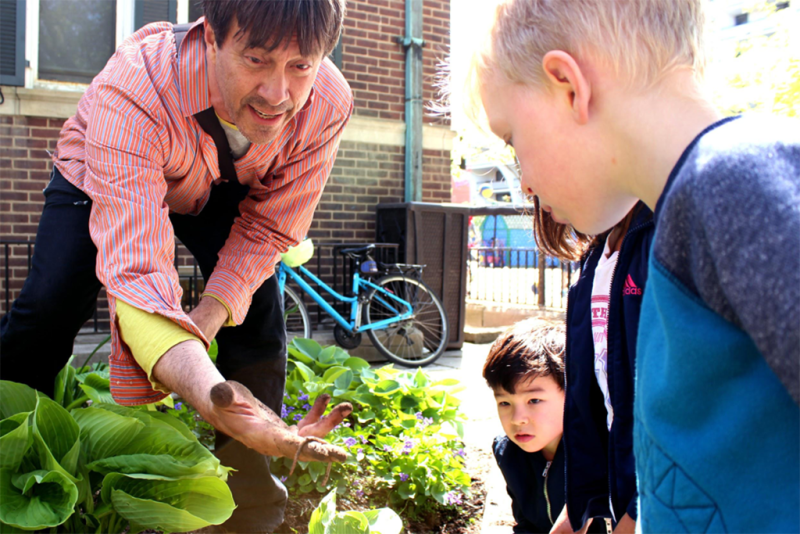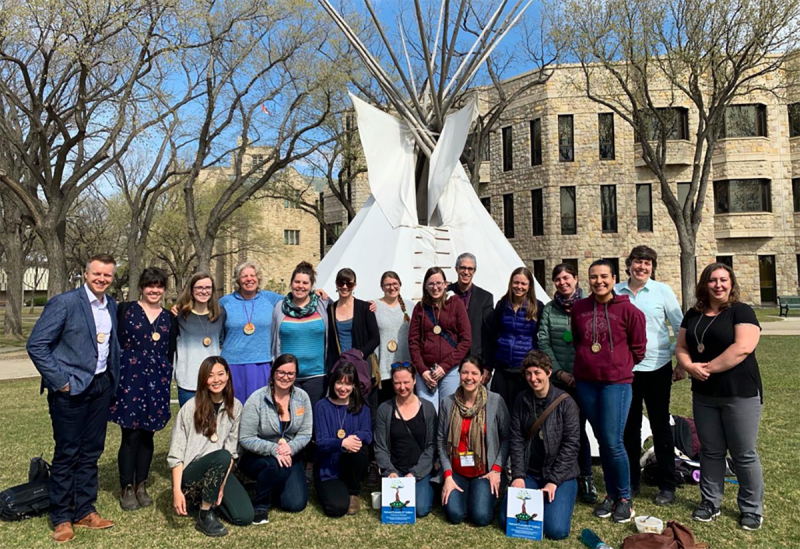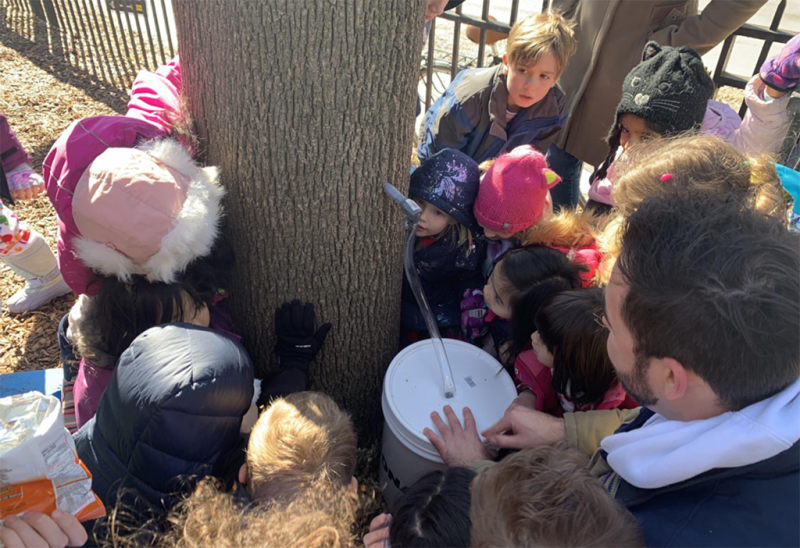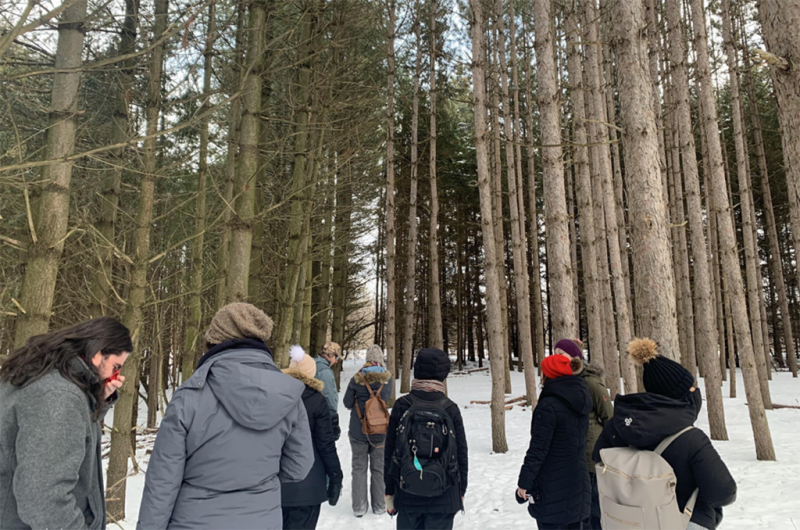June 21, 2020 | Research
Natural Curiosity: How U of T and partners enhanced Ontario's inquiry-based learning curriculum with Indigenous perspectives
By Perry King

Educator Doug Anderson supports students at the JICS Lab School with rethinking their relationship to nature (photo by Zach Pederson).
When Natural Curiosity’s first edition was released in 2011, only one page within the teacher’s resource linked its principles with Indigenous views of children and learning – although there were many points of overlap and resonance.
Environmental education should seek to build empathy and understanding of the land itself – of which perspectives from Indigenous Peoples, who have lived on that land since time immemorial and continue to have a vibrant presence, is a crucial component.
The JICS Lab School at the University of Toronto wanted to address this gap in the 2nd edition.
“[The team] realized that we needed to rethink and revise everything that was written in the first edition – that was aligned with an inquiry approach to learning. It was also important to acknowledge that’s where we are at,” said Rosa Na, Natural Curiosity’s program co-ordinator. “And as we continued to gain new perspectives and knowledge, we learned to do so with humility and through nurturing those relationships you need to grow that understanding.”
First published in 2011, Natural Curiosity: A Resource for Teachers was created to provide Ontario elementary school teachers with reassurance, clarity, and options for putting environmental inquiry into practice. The reader was the product of a two-year effort by the Natural Curiosity Program at The Dr. Eric Jackman Institute of Child Study (JICS) Laboratory School, with generous support from the Norman and Marian Robertson Charitable Foundation, anonymous donations, and artist Edward Burtynsky.
The project is a collaboration between the University and Indigenous Elders, educators and professionals
To better enable educators to meet Ontario ministry expectations for infusing environmental education throughout the curriculum, Natural Curiosity addresses and explores four branches of inquiry-based learning: inquiry and engagement, experiential learning, integrated learning and moving towards sustainability.
These four branches of inquiry were front of mind as the team commenced years of fluid, fruitful, meaningful conversations with numerous Indigenous educators, Elders and professionals. Natural Curiosity grew a relationship with Aroland First Nation and the Johnny Therriault School – which is located north of Thunder Bay, Ont., and also with the Rainy River District School Board in Fort Frances.
To respond to the recommendations by the Truth and Reconciliation Commission to bring Indigenous perspectives into the heart of Canadian educational settings, Doug Anderson – Métis/Bungee, writer, Indigenous educator, and Lab School parent – helped pen much of what would become the Indigenous lens of the second edition. Julie Comay (BA 1973 UC, MA 1977, DipCS 1992, PhD 2009), a professor of education in science and environment and one-time teacher-researcher at JICS updated and re-wrote the four branches of environmental inquiry from the western perspective of child development studies.
What came out of these relationships was Natural Curiosity 2nd Edition: The Importance of Indigenous Perspectives in Children’s Environmental Inquiry, which substantively connected the four branches of inquiry-based learning with certain Indigenous perspectives on environmental and all learning.

Developing this new edition was “taking another giant step out of the conventional classroom,” says Brenda Simon (BEd 2010), the program’s interim program director, speaking about the growing relationship between the writing team and Indigenous education consultants. “An Indigenous perspective fundamentally asks us to relocate where we think learning takes place, and asks us to rethink that colonized model of education.”
Natural Curiosity’s impact has been felt broadly. Tens of thousands of copies have been distributed to date. More than 6,000 copies of the second edition, launched in 2018, have been sold across Canada. Over a dozen colleges and universities use it in their education courses.
As uptake of Natural Curiosity 2nd Edition continues, the team wants to cultivate a professional learning culture for pre-service and in-service teachers that supports what Simon refers to as a “natural curiosity teaching practice.” This includes building regular connections with the land and natural processes into students’ experience of school, cultivating curiosity and agency in the learning process and bringing awareness of the Indigenous lens into all aspects of environmental education, both the science and the language arts that can be part of it.

Developing that culture is more important than ever, says Simon, as the task of environmental education is to achieve reconciliation with the land itself as well as to build empathy and understanding of the Indigenous nations that have lived on this land since time immemorial.
“We want to support teachers and children moving towards reciprocity with Mother Earth”
"Many teachers are very eager to bring Indigenous content into their classrooms to honor the call to Truth and Reconciliation but they’re worried about misappropriation; they’re very worried about doing it incorrectly,” said Simon, who is an OISE alumna. “They also may not have enough guidance about how to develop relationships with Indigenous educators and knowledge keepers and culture.
“Part of what we want to do, in our next phase, is encourage teachers to take responsibility by replacing fear with awareness and ordinary respectful human relating. We can provide some guidance but mistakes will necessarily be part of gaining empathy understanding. Ultimately, we want to support teachers and children moving towards reciprocity with Mother Earth.”

Building towards better professional learning
With the help of an advisory group – composed of partners in various school boards across Ontario, teachers in the Lab School, and Indigenous partners – the Natural Curiosity team to answer the following questions for their ongoing professional learning programs:
- What kind of professional learning will bring about true transformation of practice?
- How do we help educators develop trust in going outside and that by going outdoors, they will light the fire of learning through natural curiosity?
- What is needed to help educators develop trust and confidence in the unfolding of the natural processes of learning with their students?
- How do we guide educators wanting to implement Indigenous perspectives, while upholding the principle of "nothing about us, without us"?
- How do we facilitate the creation of a community of educators, for peer-to-peer support?
- What is the appropriate way for Natural Curiosity to support Indigenous educators?
For its 11th year, Natural Curiosity is sponsoring two awards to highlight educators' efforts: the Edward Burtynsky Award for Teaching Excellence in Environmental Education and the David Suzuki Fellowship Award for Excellence in Pre-Service Environmental Education. They are accepting applications until April 30, 2020. Learn about these programs and more.

